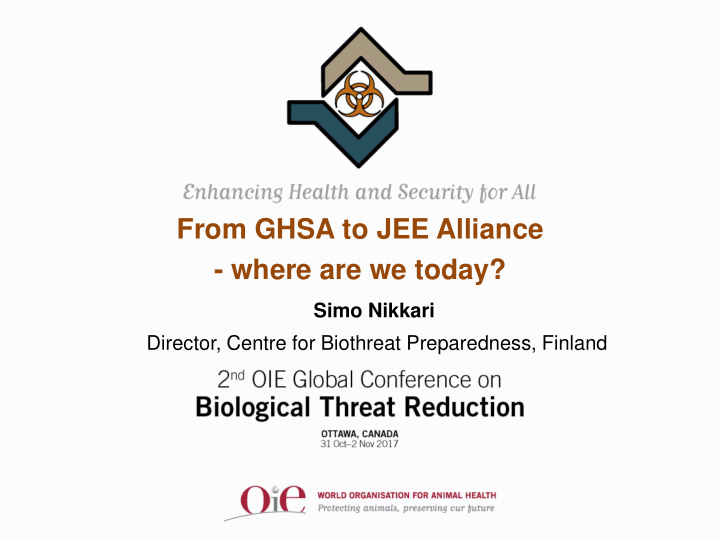



From GHSA to JEE Alliance - where are we today? Simo Nikkari Director, Centre for Biothreat Preparedness, Finland
Multisectorality - from silos to an interative approach Human health Transport Animal and health logistics Health security Civil Food capacity protection safety Trade Defense and tourism Biosafety and biosecurity Agenda 2030
The Agenda 2030 • Adopted in September 2015 by the UN Member States • Commitment to work in partnership • Target 3.d. Strengthen the capacity of all countries, in particular developing countries, for early warning, risk reduction and management of national and global health risks • Link to health security in many goals
4th GHSA High level Ministerial Meeting October 25 – 27th, 2017, Kampala, Uganda ” We, the Ministers and Heads of Delegation of Participating Countries of the Global Health Security Agenda … will continue our work to strenghten global health security, and declare our support for extending the Global Health Security Agenda until 2024 to accelerate the implementation of the International Health Regulations (2005)”
GHSA goals • Vision: A world safe and secure from global health threats posed by infectious diseases • Despite active collaboration to improve country capacities, the world is still unprepared for a large-scale sustained pandemic • What do we want to achieve? • All countries need multisectoral health security capacities to prevent, detect, and respond to human and animal disease outbreaks • Many countries need support to achieve improved capacities • Specific, measurable targets for 2024 • How we can achieve those goals? • Build on successes and lessons from 2014-2017 • Integrate with relevant frameworks, initiatives, etc.
HEALTH SECURITY AS A GOAL: iterative process to identify gaps and fill them Country Self Assessment Targets guide the country capacity is validated by an assessment and inform country action External plans and partner commitments to Assessment Team. improve health security. The results are Text Country publicly Based on the Partner Assessments disseminated. Assessment and Improved Commitments National Action Plan, Health and Country Based on the country is Investments Security evaluation supported by Capability results, specific partners’ investments action plans are in achieving Targets developed to through funding, National meet the training, Action Plans Targets and infrastructure, and address gaps. technical assistance.
Health security as a goal the process at a national level 3. improving 1. JEE 2. NAP capacity 1.1. self- 1.2. 2.1. cross- 3.1. country ownership in assessment external sectoral investing in and implementing across evaluation; national capacity building ; sectors WHO JEE process; 3.2. WHO and other IO’s technical National assistance in implementation; Action Plan 3.3. donors, financial institutions supported by other and other actors ’ assistance in evaluations e.g. OIE PVS implementation
Simulation Exercise October 25th 2017, Kampala
Mission The main purpose of the Alliance is to serve as a platform for discussion and exchange of views and experiences among partners to facilitate engagement between countries and other relevant organizations and stakeholders involved in building health security across different sectors implementing the One Health approach
Contact information Finland Australia Ms Renée Deschamps Ms Outi Kuivasniemi Renee.Deschamps@dfat.gov.au outi.kuivasniemi@stm.fi Ms Karin Clout Dr Eero Lahtinen Karin.Clout@dfat.gov.au eero.lahtinen@formin.fi Ms Kaisa Lähdepuro kaisa.lahdepuro@stm.fi www.jeealliance.org
Thank you Simo Nikkari Director, Centre for Biothreat Preparedness Helsinki, Finland simo.nikkari@mil.fi
Recommend
More recommend